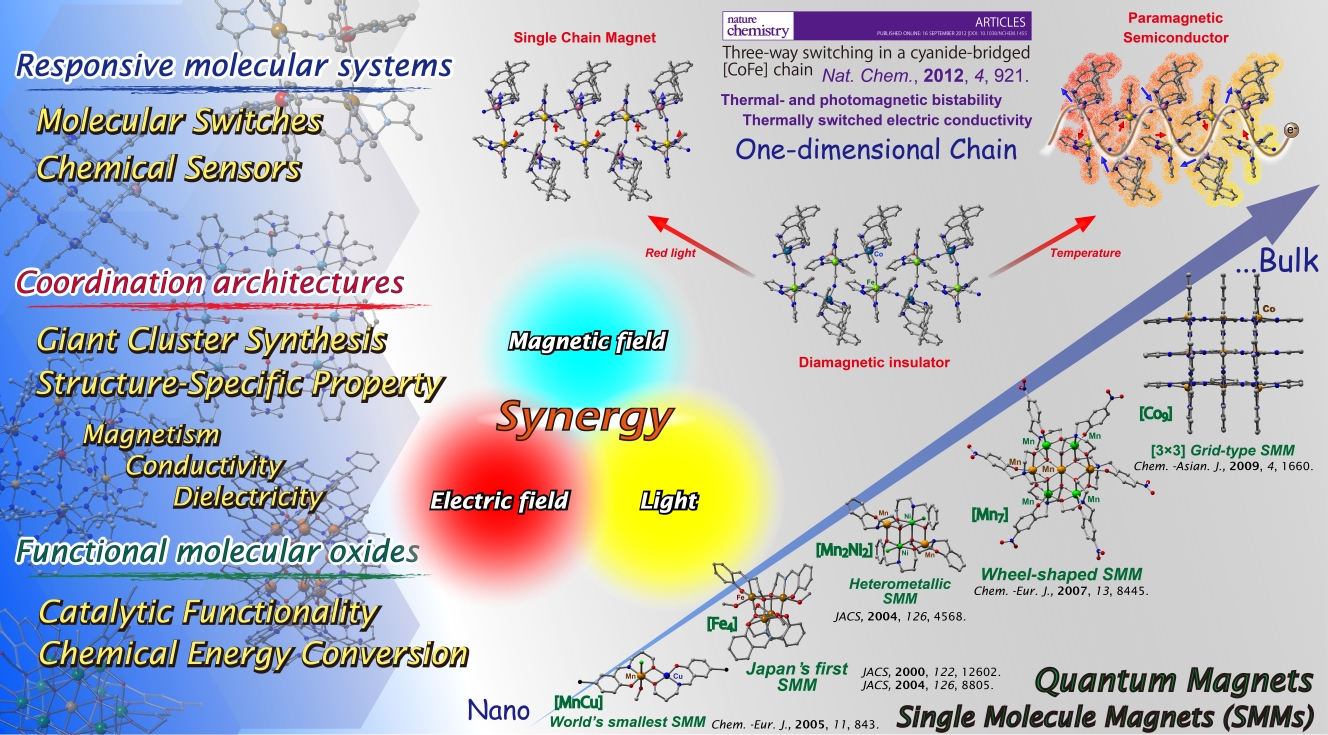
A bistable system can rest in two stable phases, at free energy minima, and switching between the phases can be achieved by the application of external stimuli such as temperature/light/pressure/host-guest interactions... Bistable molecules have, therefore, attracted intense research interest due to their potential applications in molecular switches and memory devices, for which spin-crossover (SCO) and electron transfer–active chromophores are promising building blocks. Multi-component materials, in which each component exhibits different bistability, can be expected to show synergistic properties, such as stepped phase transition and selective excitation to meta-stable states and may function as multibistable molecular switching systems.
SCO complexes can be interconverted between their high-spin (HS) and low-spin (LS) electronic configurations when suitably stimulated. We recently synthesized a [FeII4] grid and its two electron-oxidized derivative [FeII2FeIII2]. The divalent grid showed multistep thermal SCO, while the heterovalent grid showed very little thermally-induced phase transition. Green and red irradiation to the divalent grid at low temperature allowed a (4HS) meta-stable state to be accessed, but caused different responses in the heterovalent grid. The FeII and FeIII chromophores in the heterovalent grid could be selectively excited by tuning the wavelength of the applied light - the first example of site-selective light-induced SCO.
Usually reported in cyanide-bridged mixed valence (II/III) Fe-Co systems, ETCST can result in thermal and light induced magnetic switching. At high temperatures (HT) the complex will be paramagnetic (FeIIILS-CoIIHS) with a total spin of S = 1/2 + 3/2. As the sample is cooled, electron transfer occurs, from the Co ion to the Fe ion, followed rapidly by spin transition to reach a (FeIILS-CoIIILS) low temperature (LT) diamagnetic phase. We reported this behavior in a [Fe2Co2] square complex where supramolecular effects caused the HT-LT transition to occur in a two-step manner.
We also reported a complex in which the cyanide-bridged [Fe2Co2] square core was capped by two additional FeIII ions. In addition to thermal ETCST, the complex showed light-induced ETCST in which the LT state was converted into a meta-stable HT* phase. The low temperatures at which such a transition could occur meant that the spins of the neighboring metal centres were coupled, and the cluster was found to exhibit singlemolecule magnet (SMM) properties in the HT* phase and was a light-induced superparamagnet- the first example in a discrete molecular system.
In another example of the combination of functionalities within one system, a cyanide-bridged [FeCo] chain molecule was synthesized and found to show hysteretic thermal, and light-induced ETCST, and its HT* phase was also found to exhibit single chain magnet (SCM) properties. Conductivity and dielectricity measurements were also conducted over the temperature range of the thermal ETCST behavior and both were found to mimic the hysteresis shown in the magnetic measurements, with the system switching between semi-conducting in the HT phase and insulating in the LT phase. The observation of such synergistic physical properties within one multifaceted switchable system may have real implications in the design of multistable components for future nanotechnology.
Responsive Molecular Systems | Coordination Architectures | Functional Molecular Oxides
